*NURSING > EXAM > NR 222 FUNDAMENTALS EXAM 1 Practice Questions 9th Edition; With All Answers Grade A Solutions Versio (All)
NR 222 FUNDAMENTALS EXAM 1 Practice Questions 9th Edition; With All Answers Grade A Solutions Version
Document Content and Description Below
NR 222 FUNDS EXAM 1 Practice Set: Health and Wellness: Chamberlain Chapter 01: Nursing Today Potter et al.: Fundamentals of Nursing, 9th Edition MULTIPLE CHOICE 1. Which nurse most likely kept records... on sanitation techniques and the effects on health? a. Florence Nightingale b. Mary Nutting c. Clara Barton d. Lillian Wald 2. The nurse prescribes strategies and alternatives to attain expected outcome. Which standard of nursing practice is the nurse following? a. Assessment b. Diagnosis c. Planning d. Implementation 3. An experienced medical-surgical nurse chooses to work in obstetrics. Which level of proficiency is the nurse upon initial transition to the obstetrical floor? a. Novice b. Proficient c. Competent d. Advanced beginner 4. A nurse assesses a patient’s fluid status and decides that the patient needs to drink more fluids. The nurse then encourages the patient to drink more fluids. Which concept is the nurse demonstrating? a. Licensure b. Autonomy c. Certification d. Accountability 5. A nurse prepares the budget and policies for an intensive care unit. Which role is the nurse implementing? a.Educator b. Manager c. Advocate d. Caregiver 6. The nurse has been working in the clinical setting for several years as an advanced practice nurse. However, the nurse has a strong desire to pursue research and theory development. To fulfill this desire, which program should the nurse attend? a. Doctor of Nursing Science degree (DNSc) b. Doctor of Philosophy degree (PhD) c. Doctor of Nursing Practice degree (DNP) d. Doctor in the Science of Nursing degree (DSN) 7. A nurse attends a workshop on current nursing issues provided by the American Nurses Association. Which type of education did the nurse receive? a. Graduate education b. Inservice education c. Continuing education d. Registered nurse education 8. A nurse identifies gaps between local and best practices. Which Quality and Safety Education for Nurses (QSEN) competency is the nurse demonstrating? a. Safety b. Patient-centered care c. Quality improvement d. Teamwork and collaboration 9. A nurse has compassion fatigue. What is the nurse experiencing? a. Lateral violence and intrapersonal conflict b. Burnout and secondary traumatic stress c. Short-term grief and single stressor d. Physical and mental exhaustion 10. A patient is scheduled for surgery. When getting ready to obtain the informed consent, the patient tells the nurse, “I have no idea what is going to happen. I couldn’t ask any questions.” The nurse does not allow the patient to sign the permit and notifies the health care provider of the situation. Which role is the nurse displaying? a. Manager b. Patient educator c. Patient advocate d. Clinical nurse specialist 11. The patient requires routine gynecological services after giving birth to her son, and while seeing the nurse-midwife, the patient asks for a referral to a pediatrician for the newborn. Which action should the nurse-midwife take initially? a. Provide the referral as requested. b. Offer to provide the newborn care. c. Refer the patient to the supervising provider. d. Tell the patient that is not allowed to make referrals. 12. The nurse has a goal of becoming a certified registered nurse anesthetist (CRNA). Which activity is appropriate for a CRNA? a. Manages gynecological services such as PAP smears b. Works under the guidance of an anesthesiologist c. Obtains a PhD degree in anesthesiology d. Coordinates acute medical conditions 13. A nurse teaches a group of nursing students about nurse practice acts. Which information is most important to include in the teaching session about nurse practice acts? a. Protects the nurse b. Protects the public c. Protects the provider d. Protects the hospital 14. A bill has been submitted to the State House of Representatives that is designed to reduce the cost of health care by increasing the patient-to-nurse ratio from a maximum of 2:1 in intensive care units to 3:1. What should the nurse realize? a. Legislation is politics beyond the nurse’s control. b. National programs have no bearing on state politics. c. The individual nurse can influence legislative decisions. d. Focusing on nursing care provides the best patient benefit. 15. A nurse is using a guide that provides principles of right and wrong to provide care to patients. Which guide is the nurse using? a. Code of ethics b. Standards of practice c. Standards of professional performance d. Quality and safety education for nurses 16. A graduate of a baccalaureate degree program is ready to start working as an RN in the emergency department. Which action must the nurse take first? a) Obtain certification for an emergency nurse. b) Pass the National Council Licensure Examination. c) Take a course on genomics to provide competent emergency care. d) Complete the Hospital Consumer Assessment of Healthcare Providers Systems. 17. While providing care to a patient, the nurse is responsible, both professionally and legally. Which concept does this describe? a. Autonomy b. Accountability c. Patient advocacy d. Patient education 18. A nurse is teaching the staff about Benner’s levels of proficiency. In which order should the nurse place the levels from beginning level to ending level? a) Expert b) Novice c) Proficient d) Competent e) Advanced beginner a. 2, 4, 5, 1, 3 b. 2, 5, 4, 3, 1 c. 4, 2, 5, 3, 1 d. 4, 5, 2, 1, 3 MULTIPLE RESPONSE 1. A nurse is preparing a teaching session about contemporary influences on nursing. Which examples should the nurse include? (Select all that apply.) a. Human rights b. Affordable Care Act c. Demographic changes d. Medically underserved e. Decreasing health care costs 2. After licensure, the nurse wants to stay current in knowledge and skills. Which programs are the most common ways nurses can do this? (Select all that apply.) a. Master’s degree b. Inservice education c. Doctoral preparation d. Continuing education e. National Council Licensure Examination retakes 3. A nurse wants to become an advanced practice registered nurse. Which options should the nurse consider? (Select all that apply.) a. Patient advocate b. Nurse administrator c. Certified nurse-midwife d. Clinical nurse specialist e. Certified nurse practitioner 4. The nurse manager from the oncology unit has had two callouts; the orthopedic unit has had multiple discharges and probably will have to cancel one or two of its nurses. The orthopedic unit has agreed to “float” two of its nurses to the oncology unit if oncology can “float” a nursing assistant to the orthopedic unit to help with obtaining vital signs. Which concepts does this situation entail? (Select all that apply.) a. Autonomy b. Informatics c. Accountability d. Political activism e. Teamwork and collaboration Chapter 06: Health and Wellness Potter et al.: Fundamentals of Nursing, 9th Edition MULTIPLE CHOICE 1. A nurse is teaching about the goals of Healthy People 2020. Which information should the nurse include in the teaching session? a. Eliminate health disparities in America. b. Eliminate health behaviors in America. c. Eliminate quality of life in America. d. Eliminate healthy life in America. 2. A nurse is following the goals of Healthy People 2020 to provide care. Which action should the nurse take? Allow people to continue current behaviors to reduce the stress of change. Focus only on health changes that will lead to better local communities. Create social and physical environments that promote good health. Focus on illness treatment to provide fast recuperation. 3. A nurse is using the World Health Organization definition of health to provide care. Which area will the nurse focus on while providing care? a. Making sure the patients are disease free b. Making sure to involve the whole person c. Making sure care is strictly personal in nature d. Making sure to focus only on the pathological state 4. The nurse is preparing a smoking cessation class for family members of patients with lung cancer. The nurse believes that the class will convert many smokers to nonsmokers once they realize the benefits of not smoking. Which health care model is the nurse following? a. Health belief model b. Holistic health model c. Health promotion model d. Maslow’s hierarchy of needs 5. A nurse is using Maslow’s hierarchy to prioritize care for an anxious patient that is not eating and will not see family members. Which area should the nurse address first? a. Anxiety b. Not eating c. Mental health d. Not seeing family members 6. The patient is reporting moderate incisional pain that was not relieved by the last dose of pain medication. The patient is not due for another dose of medication for another 2 1/2 hours. The nurse repositions the patient, asks what type of music the patient likes, and sets the television to the channel playing that type of music. Which health care model is the nurse using? a. Health belief model b. Holistic health model c. Health promotion model d. Maslow’s hierarchy of needs 7. A nurse is assessing internal variables that are affecting the patient’s health status. Which area should the nurse assess? a. Perception of functioning b. Socioeconomic factors c. Cultural background d. Family practices 8. The nurse is admitting a patient with uncontrolled diabetes mellitus. It is the fourth time the patient is being admitted in the last 6 months for high blood sugars. During the admission process, the nurse asks the patient about employment status and displays a nonjudgmental attitude. What is the rationale for the nurse’s actions? a) External variables have little effect on compliance. b) A person’s compliance is affected by economic status. c) Employment status is an internal variable that impacts compliance. d) Noncompliant patients thrive on the disapproval of authority figures. 9. The nurse is working on a committee to evaluate the need for increasing the levels of fluoride in the drinking water of the community. Which concept is the nurse fostering? a. Illness prevention b. Wellness education c. Active health promotion d. Passive health promotion 10. The nurse is working in a clinic that is designed to provide health education and immunizations. Which type of preventive care is the nurse providing? a. Primary prevention b. Secondary prevention c. Tertiary prevention d. Risk factor prevention 11. The patient is admitted to the emergency department of the local hospital from home with reports of chest discomfort and shortness of breath. The patient is placed on oxygen, has labs and blood gases drawn, and is given an electrocardiogram and breathing treatments. Which level of preventive care is this patient receiving? a. Primary prevention b. Secondary prevention c. Tertiary prevention d. Health promotion 12. A patient is admitted to a rehabilitation facility following a stroke. The patient has right-sided paralysis and is unable to speak. The patient will be receiving physical therapy and speech therapy. Which level of preventive care is the patient receiving? a. Primary prevention b. Secondary prevention c. Tertiary prevention d. Health promotion 13. Upon completing a history, the nurse finds that a patient has risk factors for lung disease. How should the nurse interpret this finding? a) A person with the risk factor will get the disease. b) The chances of getting the disease are increased. c) Risk modification will have no effect on disease prevention. d) The disease is guaranteed not to develop if the risk factor is controlled. 14. The nurse is caring for a patient who has been trying to quit smoking. The patient has been smoke free for 2 weeks but had two cigarettes last night and at least two this morning. What should the nurse anticipate? a) The patient does not want to and will never quit smoking. b) The patient must pick up the attempt right where the patient left off. c) The patient will return to the contemplation or precontemplation phase. d) The patient will need to adopt a new lifestyle for change to be effective. 15. The nurse is working in a drug rehabilitation clinic and is in the process of admitting a patient for “detox.” What should the nurse do next? a. Identify the patient’s stage of change. b. Realize that the patient is ready to change. c. Teach the patient that choices will have to change. a. Instruct the patient that relapses will not be tolerated. 16. A female patient has been overweight for most of her life. She has tried dieting in the past and has lost weight, only to regain it when she stopped dieting. The patient is visiting the weight loss clinic/health club because she has decided to do it. She states that she will join right after the holidays, in 3 months. Which stage is the patient displaying? a. Precontemplation b. Contemplation c. Preparation d. Action 17. Upon completion of the assessment, the nurse finds that the patient has quit drinking and has been alcohol free for the past 2 years. Which stage best describes the nurse’s assessment finding? a. Contemplation b. Maintenance c. Preparation d. Action 18. The patient had a colostomy placed 1 week ago. When approached by the nurse, the patient and spouse refuse to talk about it and refuse to be taught about how to care for it. How will the nurse evaluate this couple’s stage of adjustment? a. Shock b. Withdrawal c. Acceptance d. Rehabilitation 19. A patient has had emphysema (lung disease) for many years. When approached by the nurse, the patient states “I would be better off dead.” The patient supports the family, and now because of oxygen dependency the patient must quit work. The patient’s spouse will have to go to work. Which action should the nurse take? a.Develop a plan of care for the family. b.Contact psychiatric services for a referral. c.Assure the patient that things will work out. d.Focus the plan of care solely on maximizing patient function. 20. A nurse is teaching about the transtheoretical model of change. In which order will the nurse place the progression of the stages from beginning to end? a) Action b) Preparation c) Maintenance d) Contemplation e) Precontemplation a. 5, 4, 2, 1, 3 b. 2, 5, 4, 3, 1 c. 4, 5, 3, 1, 2 d. 1, 5, 2, 3, 4 MULTIPLE RESPONSE 1. Which areas should the nurse assess to determine the effects of external variables on a patient’s illness? (Select all that apply.) a. Patient’s perception of the illness b. Patient’s coping skills c. Socioeconomic status d. Cultural background e. Social support 2. A nurse meets the following goals: helps a patient maintain health and helps a patient with an illness. Which factors assist the nurse in achieving these goals? (Select all that apply.) a. Understands the challenges of today’s health care system b. Identifies actual and potential risk factors c. Has coined the term “illness behavior” d. Minimizes the effects of illnesses e. Experiences compassion fatigue Chapter 16: Nursing Assessment Potter et al.: Fundamentals of Nursing, 9th Edition MULTIPLE CHOICE 1. The nurse is using critical thinking skills during the first phase of the nursing process. Which action indicates the nurse is in the first phase? a. Completes a comprehensive database b. Identifies pertinent nursing diagnoses c. Intervenes based on priorities of patient care d. Determines whether outcomes have been achieved 2. A nurse is using the problem-oriented approach to data collection. Which action will the nurse take first? a. Complete the questions in chronological order. b. Focus on the patient’s presenting situation. c. Make accurate interpretations of the data.- Diagnoses d. Conduct an observational overview. 3. After reviewing the database, the nurse discovers that the patient’s vital signs have not been recorded by the nursing assistive personnel (NAP). Which clinical decision should the nurse make? a) Administer scheduled medications assuming that the NAP would have reported abnormal vital signs. b) Have the patient transported to the radiology department for a scheduled x-ray, and review vital signs upo c) Ask the NAP to record the patient’s vital signs before administering medications. d) Omit the vital signs because the patient is presently in no distress. 4. The nurse is gathering data on a patient. Which data will the nurse report as objective data? a. States “doesn’t feel good” b. Reports a headache c. Respirations 16 d. Nauseated 5. A patient expresses fear of going home and being alone. Vital signs are stable and the incision is nearly completely healed. What can the nurse infer from the subjective data? a) The patient can now perform the dressing changes without help. b) The patient can begin retaking all of the previous medications. c) The patient is apprehensive about discharge. d) The patient’s surgery was not successful. 6. Which method of data collection will the nurse use to establish a patient’s database? a) Reviewing the current literature to determine evidence-based nursing actions b) Checking orders for diagnostic and laboratory tests c) Performing a physical examination d) Ordering medications 7. A nurse is gathering information about a patient’s habits and lifestyle patterns. Which method of data collection will the nurse use that will best obtain this information? a. Carefully review lab results. b. Conduct the physical assessment. c. Perform a thorough nursing health history. d. Prolong the termination phase of the interview. 8. While interviewing an older female patient of Asian descent, the nurse notices that the patient looks at the ground when answering questions. What should the nurse do? a) Consider cultural differences during this assessment. b) Ask the patient to make eye contact to determine her affect. c) Continue with the interview and document that the patient is depressed. d) Notify the health care provider to recommend a psychological evaluation. 9. A nurse has already set the agenda during a patient-centered interview. What will the nurse do next? a) Begin with introductions. b) Ask about the chief concerns or problems. c) Explain that the interview will be over in a few minutes. d) Tell the patient “I will be back to administer medications in 1 hour.” 10. The nurse is attempting to prompt the patient to elaborate on the reports of daytime fatigue. Which question should the nurse ask? a) “Is there anything that you are stressed about right now that I should know?” b) “What reasons do you think are contributing to your fatigue?” c) “What are your normal work hours?” d) “Are you sleeping 8 hours a night?” 11. A nurse is conducting a nursing health history. Which component will the nurse address? a. Nurse’s concerns b. Patient expectations c. Current treatment orders d. Nurse’s goals for the patient 12. While the patient’s lower extremity, which is in a cast, is assessed, the patient tells the nurse about an inability to rest at night. The nurse disregards this information, thinking that no correlation has been noted between having a leg cast and developing restless sleep. Which action would have been best for the nurse to take? a) Tell the patient to just focus on the leg and cast right now. b) Document the sleep patterns and information in the patient’s chart. c) Explain that a more thorough assessment will be needed next shift. d) Ask the patient about usual sleep patterns and the onset of having difficulty resting. 13. The nurse begins a shift assessment by examining a surgical dressing that is saturated with serosanguineous drainage on a patient who had open abdominal surgery yesterday (or 1 day ago). Which type of assessment approach is the nurse using? a. Gordon’s Functional Health Patterns b. Activity-exercise pattern assessment c. General to specific assessment d. Problem-oriented assessment 14. Which statement by a nurse indicates a good understanding about the differences between data validation and data interpretation? a) “Data interpretation occurs before data validation.” b) “Validation involves looking for patterns in professional standards.” c) “Validation involves comparing data with other sources for accuracy.” d) “Data interpretation involves discovering patterns in professional standards.” 15. Which scenario best illustrates the nurse using data validation when making a nursing clinical decision for a patient? a) The nurse determines to remove a wound dressing when the patient reveals the time of the last dressing change and notices old and new drainage. b) The nurse administers pain medicine due at 1700 at 1600 because the patient reports increased pain and the family wants something done. c) The nurse immediately asks the health care provider for an order of potassium when a patient reports leg cramps. d) The nurse elevates a leg cast when the patient reports decreased mobility. 16. While completing an admission database, the nurse is interviewing a patient who states “I am allergic to latex.” Which action will the nurse take first? a) Immediately place the patient in isolation. b) Ask the patient to describe the type of reaction. c) Proceed to the termination phase of the interview. d) Document the latex allergy on the medication administration record. 17. A patient verbalizes a low pain level of 2 out of 10 but exhibits extreme facial grimacing while moving around in bed. What is the nurse’s initial action in response to these observations? a) Proceed to the next patient’s room to make rounds. b) Determine the patient does not want any pain medicine. c) Ask the patient about the facial grimacing with movement. d) Administer the pain medication ordered for moderate to severe pain. 18. The nurse is interviewing a patient with a hearing deficit. Which area should the nurse use to conduct this interview? a) The patient’s room with the door closed b) The waiting area with the television turned off c) The patient’s room before administration of pain medication d) The waiting room while the occupational therapist is working on leg exercises 19. A new nurse is completing an assessment on an 80-year-old patient who is alert and oriented. The patient’s daughter is present in the room. Which action by the nurse will require follow-up by the charge nurse? a. The nurse makes eye contact with the patient. b. The nurse speaks only to the patient’s daughter. c. The nurse leans forward while talking with the patient. d. The nurse nods periodically while the patient is speaking. MULTIPLE RESPONSE 1. A nurse is completing an assessment. Which findings will the nurse report as subjective data? (Select all that apply.) a. Patient’s temperature b. Patient’s wound appearance c. Patient describing excitement about discharge d. Patient pacing the floor while awaiting test results e. Patient’s expression of fear regarding upcoming surgery MATCHING A nurse is completing an assessment using the PQRST to obtain data about the patient’s chest pain. Match the questions to the components of the PQRST that the nurse will be using. a. Where is the pain located? 3 b. What causes the pain? 1 c. Does it come and go? 5 d. What does the pain feel like? 2 e. What is the rating on a scale of 0 to 10? 4 1. Provokes Quality Radiate Severity 5.Time Chapter 22: Ethics and Values Potter et al.: Fundamentals of Nursing, 9th Edition MULTIPLE CHOICE 1. Four patients in labor all request epidural analgesia to manage their pain at the same time. Which ethical principle ismost compromised when only one nurse anesthetist is on call? a. Justice b. Fidelity c. Beneficence d. Nonmaleficence 2. The patient reports to the nurse of being afraid to speak up regarding a desire to end care for fear of upsetting spouse and children. Which principle in the nursing code of ethics ensures that the nurse will promote the patient’s cause? a. Advocacy b. Responsibility c. Confidentiality d. Accountability 3. The patient’s son requests to view documentation in the medical record. What is the nurse’s best response to this request? a. “I’ll be happy to get that for you.” b. “You are not allowed to look at it.” c. “You will need your mother’s permission.” d. “I cannot let you see the chart without a doctor’s order.” 4. When professionals work together to solve ethical dilemmas, nurses must examine their own values. What is thebest rationale for this step? a. So fact is separated from opinion b. So different perspectives are respected c. So judgmental attitudes can be provoked d. So the group identifies the one correct solution 5. A nurse is experiencing an ethical dilemma with a patient. Which information indicates the nurse has a correct understanding of the primary cause of ethical dilemmas? a. Unequal power b. Presence of conflicting values c. Judgmental perceptions of patients d. Poor communication with the patient 6. The nurse questions a health care provider’s decision to not tell the patient about a cancer diagnosis. Which ethical principle is the nurse trying to uphold for the patient? a. Consequentialism b. Autonomy c. Fidelity d. Justice 7. The nurse finds it difficult to care for a patient whose advance directive states that no extraordinary resuscitation measures should be taken. Which step may help the nurse to find resolution in this assignment? a. Scrutinize personal values. b. Call for an ethical committee consult. c. Decline the assignment on religious grounds. d. Convince the family to challenge the directive. 8. The nurse values autonomy above all other principles. Which patient assignment will the nurse find most difficult to accept? a) Older-adult patient who requires dialysis b) Teenager in labor who requests epidural anesthesia c) Middle-aged father of three with an advance directive declining life support d) Family elder who is making the decisions for a young-adult female member 9. A nurse must make an ethical decision concerning vulnerable patient populations. Which philosophy of health care ethics would be particularly useful for this nurse? a. Teleology b. Deontology c. Utilitarianism d. Feminist ethics 10. A nurse agrees with regulations for mandatory immunizations of children. The nurse believes that immunizations prevent diseases as well as prevent spread of the disease to others. Which ethical framework is the nurse using? a. Deontology b. Ethics of care c. Utilitarianism d. Feminist ethics 11. The nurse has become aware of missing narcotics in the patient care area. Which ethical principle obligates the nurse to report the missing medications? a. Advocacy b. Responsibility c. Confidentiality d. Accountability 12. A young woman who is pregnant with a fetus exposed to multiple teratogens consents to have her fetus undergo serial PUBS (percutaneous umbilical blood sampling) to examine how exposure affects the fetus over time. Although these tests will not improve the fetus’s outcomes and will expose it to some risks, the information gathered may help infants in the future. Which ethical principle is at greatest risk? a. Fidelity b. Autonomy c. Beneficence d. Nonmaleficence 13. A nurse is discussing quality of life issues with another colleague. Which topic will the nurse acknowledge for increased attention paid to quality of life concerns? a. Health care disparities b. Aging of the population c. Abilities of disabled persons d. Health care financial reform 14. Which action by the nurse indicates a safe and efficient use of social networks? a. Promotes support for a local health charity b. Posts a picture of a patient’s infected foot c. Vents about a patient problem at work d. Friends a patient 15. The nurse is caring for a dying patient. Which intervention is considered futile? a. Giving pain medication for pain b. Providing oral care every 5 hours c. Administering the influenza vaccine d. Supporting lower extremities with pillows 16. During a severe respiratory epidemic, the local health care organizations decide to give health care workers priority access to ventilators over other members of the community who also need that resource. Which philosophy would give the strongest support for this decision? a. Deontology b. Utilitarianism c. Ethics of care d. Feminist ethics 17. A nurse is teaching a patient and family about quality of life. Which information should the nurse include in the teaching session about quality of life? a. It is deeply social. b. It is hard to define. c. It is an observed measurement for most people. d. It is consistent and stable over the course of one’s lifetime. 18. The nurse is caring for a patient supported with a ventilator who has been unresponsive since arrival via ambulance 8 days ago. The patient has not been identified, and no family members have been found. The nurse is concerned about the plan of care regarding maintenance or withdrawal of life support measures. Place the steps the nurse will use to resolve this ethical dilemma in the correct order. a) The nurse identifies possible solutions or actions to resolve the dilemma. b) The nurse reviews the medical record, including entries by all health care disciplines, to gather information relevant to this patient’s situation. c) Health care providers use negotiation to redefine the patient’s plan of care. d) The nurse evaluates the plan and revises it with input from other health care providers as necessary. e) The nurse examines the issue to clarify opinions, values, and facts. f) The nurse states the problem. a. 6, 1, 2, 5, 4, 3 b. 5, 6, 2, 3, 4, 1 c. 1, 2, 5, 4, 3, 6 d. 2, 5, 6, 1, 3, 4 MULTIPLE RESPONSE 1. A nurse is a member of the ethics committee. Which purposes will the nurse fulfill in this committee? (Select all that apply.) a. Education b. Case consultation c. Purchasing power d. Direct patient care e. Policy recommendation 09: Cultural Awareness Potter et al.: Fundamentals of Nursing, 9th Edition MULTIPLE CHOICE 1. A nurse is working at a health fair screening people for liver cancer. Which population group should the nurse monitor most closely for liver cancer? a. Hispanic b. Asian Americans c. Non-Hispanic Caucasians d. Non-Hispanic African-Americans 2. A nurse is caring for an immigrant with low income. Which information should the nurse consider when planning care for this patient? a. There is a decreased frequency of morbidity. b. There is an increased incidence of disease. c. There is an increased level of health. d. There is a decreased mortality rate. 3. A nurse is assessing the health care disparities among population groups. Which area is the nurse monitoring? a. Accessibility of health care services b. Outcomes of health conditions c. Prevalence of complications d. Incidence of diseases 4. A nurse is providing care to a patient from a different culture. Which action by the nurse indicates cultural competence? a. Communicates effectively in a multicultural context b. Functions effectively in a multicultural context c. Visits a foreign country d. Speaks a different language 5. The nurse learns about cultural issues involved in the patient’s health care belief system and enables patients and families to achieve meaningful and supportive care. Which concept is the nurse demonstrating? a. Marginalized groups b. Health care disparity c. Transcultural nursing d. Culturally congruent care 6. A nurse is beginning to use patient-centered care and cultural competence to improve nursing care. Which step should the nurse take first? a. Assessing own biases and attitude b. Learning about the world view of others c. Understanding organizational forces d. Developing cultural skills 7. A nurse is performing a cultural assessment using the ETHNIC mnemonic for communication. Which area will the nurse assess for the “H”? a. Health b. Healers c. History d. Homeland 8. The nurse is caring for a patient of Hispanic descent who speaks no English. The nurse is working with an interpreter. Which action should the nurse take? a. Use long sentences when talking. b. Look at the patient when talking. c. Use breaks in sentences when talking. d. Look at only nonverbal behaviors when talking. 9. Which action indicates the nurse is meeting a primary goal of cultural competent care for patients? a. Provides care to transgender patients b. Provides care to restore relationships c. Provides care to patients that is individualized d. Provides care to surgical patients 10. The nurse is caring for a Chinese patient using the Teach-Back technique. Which action by the nurse indicates successful implementation of this technique? a) Asks, “Does this make sense?” b) Asks, “Do you think you can do this at home?” c) Asks, “What will you tell your spouse about changing the dressing?” d) Asks, “Would you tell me if you don’t understand something so we can go over it?” 11. A nurse is using core measures to reduce health disparities. Which group should the nurse focus on to cause themost improvement in core measures? a. Caucasians b. Poor people c. Alaska Natives d. American Indians 12. A nurse is designing a form for lesbian, gay, bisexual, and transgender (LGBT) patients. Which design should the nurse use? a. Use partnered rather than married. b. Use mother rather than father. c. Use parents rather than guardian. d. Use wife/husband rather than significant other. 13. A nurse is assessing population groups for the risk of suicide requiring medical attention. Which group should the nurse monitor most closely? a. Young bisexuals b. Young caucasians c. Asian Americans d. African-Americans 14. A nurse is assessing a patient’s ethnohistory. Which question should the nurse ask? a) What language do you speak at home? b) How different is your life here from back home? c) Which caregivers do you seek when you are sick? d) How different is what we do from what your family does when you are sick? 15. A nurse is teaching patients about health care information. Which patient will the nurse assess closely for health literacy? a. A patient 35 years old b. A patient 68 years old c. A patient with a college degree d. A patient with a high-school diploma 16. A nurse works at a hospital that uses equity-focused quality improvement. Which strategy is the hospital using? a. Document staff satisfaction. b. Focus on the family. c. Implement change on a grand scale. d. Reduce disparities. 17. A nurse is providing care to a culturally diverse population. Which action indicates the nurse is successful in the role of providing culturally congruent care? a) Provides care that fits the patient’s valued life patterns and set of meanings b) Provides care that is based on meanings generated by predetermined criteria c) Provides care that makes the nurse the leader in determining what is needed d) Provides care that is the same as the values of the professional health care system 18. A nurse is assessing the patient’s meaning of illness. Which area of focus by the nurse is priority? a. On the way a patient reacts to disease b. On the malfunctioning of biological processes c. On the malfunctioning of psychological processes d. On the way a patient reacts to family/social interactions MULTIPLE RESPONSE 1. A nurse is using Campinha-Bacote’s model of cultural competency. Which areas will the nurse focus on to become competent? (Select all that apply.) a. Cultural skills b. Cultural desire c. Cultural transition d. Cultural knowledge e. Cultural encounters 2. A nurse is using the RESPECT mnemonic to establish rapport, the “R” in RESPECT. Which actions should the nurse take? (Select all that apply.) a) Connect on a social level. b) Help the patient overcome barriers. c) Consciously attempt to suspend judgment. d) Stress that they will be working together to address problems. e) Know limitations in addressing medical issues across cultures. 3. A nurse is using the explanatory model to determine the etiology of an illness. Which questions should the nurse ask? (Select all that apply.) a. How should your sickness be treated? b. What do you call your problem? c. How does this illness work inside your body? d. What do you fear most about your sickness? e. What name does it have? MATCHING A nurse is using Campinha-Bacote’s model of cultural competency to improve cultural care. Which actions describe the components the nurse is using? a) In-depth self-examination of one’s own background b) Ability to assess factors that influence treatment and care c) Sufficient comparative understanding of diverse groups d) Motivation and commitment to continue learning about cultures e) Cross-cultural interaction that develops communication skills Cultural skills Cultural desires Cultural awareness Cultural knowledge Cultural encounters Chapter 10: Caring for Families Potter et al.: Fundamentals of Nursing, 9th Edition MULTIPLE CHOICE 1. A nurse is assessing the family unit to determine the family’s ability to adapt to the change of a member having surgery. Which area is the nurse monitoring? a. Family durability b. Family resiliency c. Family diversity d. Family forms 2. A nurse reviews the current trends affecting the family. Which trend will the nurse find? a. Mothers are staying at home. b. Adolescent mothers usually live on their own. c. More grandparents are raising their grandchildren. d. Teenage fathers usually have stronger support systems. 3. A spouse brings the children in to visit their mother in the hospital. The nurse asks how the family is doing. The husband states, “None of her jobs are getting done, and I don’t do those jobs, so the house and the kids are falling apart.” How will the nurse interpret this finding? a. The family structure is resilient. b. The family structure is flexible. c. The family structure is hardy. d. The family structure is rigid. 4. A nurse cares for the family’s as well as the patient’s needs using available resources. Which approach is the nurse using? a. Family as context b. Family as patient c. Family as system d. Family as caregivers 5. A nurse is caring for a patient who needs constant care in the home setting and for whom most of the care is provided by the patient’s family. Which action should the nurse take to help relieve stress? a. Encourage caregiver to do as much as possible. b. Focus primarily on the patient. c. Point out weaknesses. d. Provide education. 6. A nurse is working with a patient. When the nurse asks about family members, the patient states that it includes my spouse, children, and aunt and uncle. How will the nurse describe this type of family? a. Nuclear b. Blended c. Extended d. Alternative 7. A nurse is assessing a child that lives in a car with family members who presents to the emergency department. Which area should the nurse assess closely? a. Ears b. Eyes c. Head d. Hands 8. The nurse is interviewing a patient who is being admitted to the hospital. The patient’s family went home before the nurse’s interview. The nurse asks the patient, “Who decides when to come to the hospital?” What is the rationale for the nurse’s action? a. To assess the family form b. To assess the family function c. To assess the family structure d. To assess the family generalization 9. A nurse is caring for a patient from a motor vehicle accident. Which action by the unlicensed assistive personnel will cause the nurse to intervene? a. Tells the family not to leave the bedside b. Offers the family a sandwich c. Gives the family a blanket d. Sits with the family 10. A nurse is using the family as context approach to provide care to a patient. What should the nurse do next? a) Assess family patterns versus individual characteristics. b) Assess how much the family provides the patient’s basic needs. c) Use “family as patient” and “family as context” approaches simultaneously. d) Plan care to meet not only the patient’s needs but those of the family as well. 11. The nurse is caring for a patient in hospice. The nurse notes that the patient is getting adequate care, but the spouse is not sleeping well. The nurse also assesses the need for better family nutrition and meals assistance. The nurse discusses these needs with the patient and family and develops a plan of care with them using community resources. Which approach is the nurse using? a. Family as context b. Family as patient c. Family as system d. Family as caregiver 12. The nurse is caring for an older adult patient who has no apparent family. When questioned about family and the definition of family, the patient states, “I have no family. They’re all gone.” When asked, “Who prepares your meals?” the patient states, “I do, or I go out.” Which approach should the nurse use for this patient? a. Family as context b. Family as patient c. Family as system d. Family as caregiver 13. The nurse is caring for an older adult patient at home who requires teaching for dressing changes. The spouse and adult child are also involved in changing the dressing. Which statement by the nurse will most likely elicit a positive response from the patient and family? a) “You’re doing that all wrong. Let me show you how to do it.” b) “I don’t know who showed you how to change a dressing, but you’re not doing it right. Let me show you c) “You’re hesitant about changing the dressing like I was before I was shown an easier way; would you lik d) “I used to change the dressing the same way you are doing it: the wrong way. I’ll show you the right way 14. The nurse is providing discharge teaching for an older-adult patient who will need tube feedings at home. The spouse is the only source of care and states “I will not be able to perform the feedings due to arthritis.” Which action should the nurse take? a. Obtain extra feeding supplies. b. Arrange for home care. c. Cancel the discharge. d. Teach the spouse. MULTIPLE RESPONSE 1. A nurse is assessing threats concerning the family. Which areas will the nurse include in the assessment? (Select all that apply.) a. Homelessness b. Domestic violence c. Presence of illness d. Changing economic status e. Rise of homosexual families 2. A nurse is assessing the realms of family life. Which processes will the nurse assess? (Select allthat apply.) a. Developmental b. Interactive c. Integrity d. Coping e. Life MATCHING A nurse is focusing on the interactive processes of family life and is asking the patient questions. Match the questions the nurse will ask to the interactive process. a. Intimacy expression b. Social support c. Roles d. Family nurturing Who is the “peacekeeper” of the family? How are house rules established? How often does the family hug each other? Who at your workplace is close to the family [Show More]
Last updated: 1 month ago
Preview 1 out of 10 pages

Reviews( 0 )
Recommended For You
*NURSING> EXAM > ATI COMPREHENSIVE EXIT FINAL Comprehensive Questions and Answers Grade A+ (All)

ATI COMPREHENSIVE EXIT FINAL Comprehensive Questions and Answers Grade A+
1) A nurse in an emergency department completes an assessment on an adolescent client that has conduct disorder. The client threatened suicide to teacher at school. Which of the following statements s...
By Quiz Merchant , Uploaded: Mar 08, 2021
$9
*NURSING> EXAM > NR 508 / NR508: Advanced Pharmacology Midterm Exam Week 4 – Question and Answers GRADE A - (2021/2022) Chamberlain College of Nursing. (All)
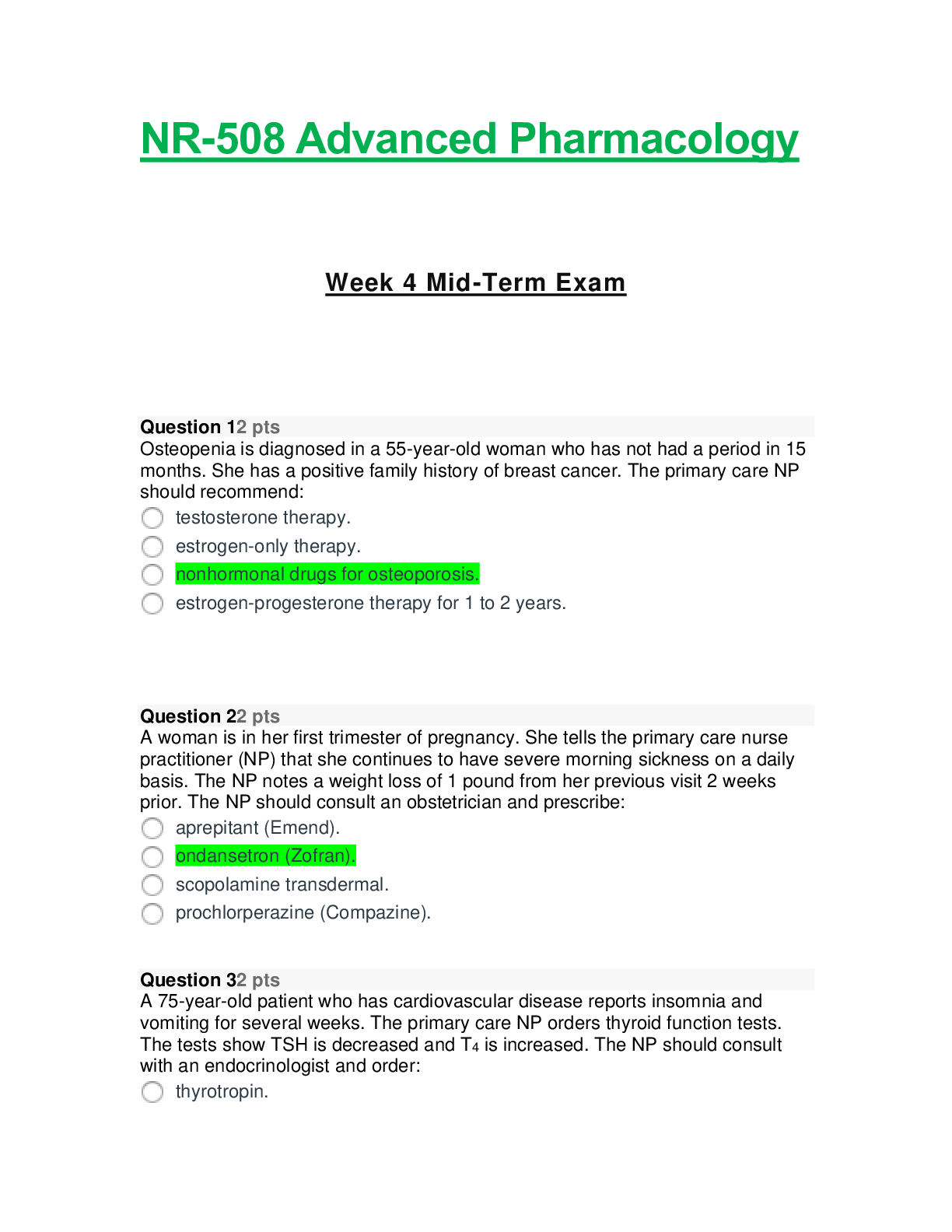
NR 508 / NR508: Advanced Pharmacology Midterm Exam Week 4 – Question and Answers GRADE A - (2021/2022) Chamberlain College of Nursing.
NR508: Advanced Pharmacology Midterm Exam Week 4
By quiz_bit , Uploaded: Jan 21, 2021
$6
*NURSING> EXAM > NR224 / NR 224: Fundamentals Exam 1 (Latest Update) Chamberlain College of Nursing (All)
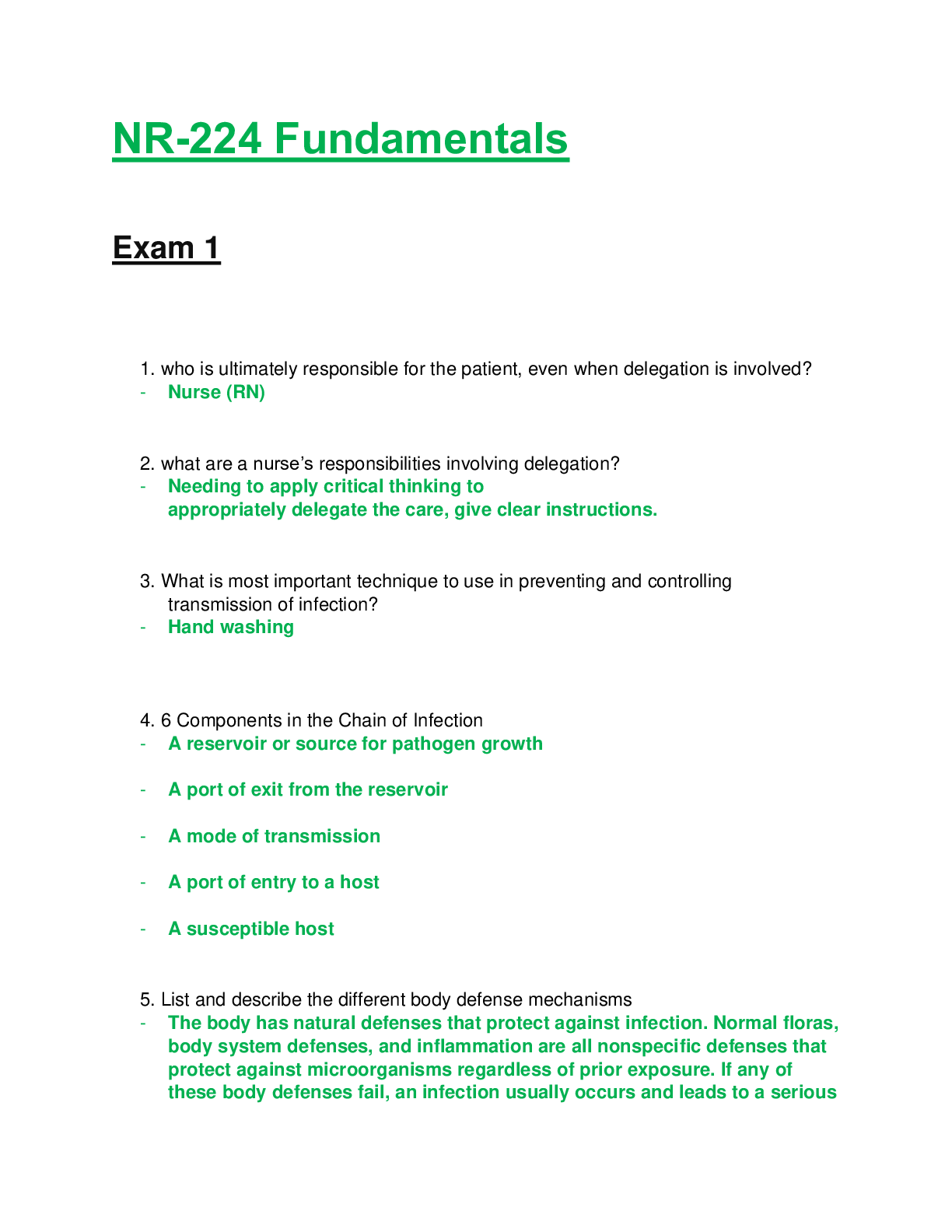
NR224 / NR 224: Fundamentals Exam 1 (Latest Update) Chamberlain College of Nursing
NR-224 Fundamentals Exam 1 1. who is ultimately responsible for the patient, even when delegation is involved? - Nurse (RN) 2. what are a nurse’s responsibilities involving delegation? -...
By quiz_bit , Uploaded: Nov 17, 2020
$16
*NURSING> EXAM > NR224 / NR 224: Fundamentals Exam 1 Latest Update Chamberlain College of Nursing (All)
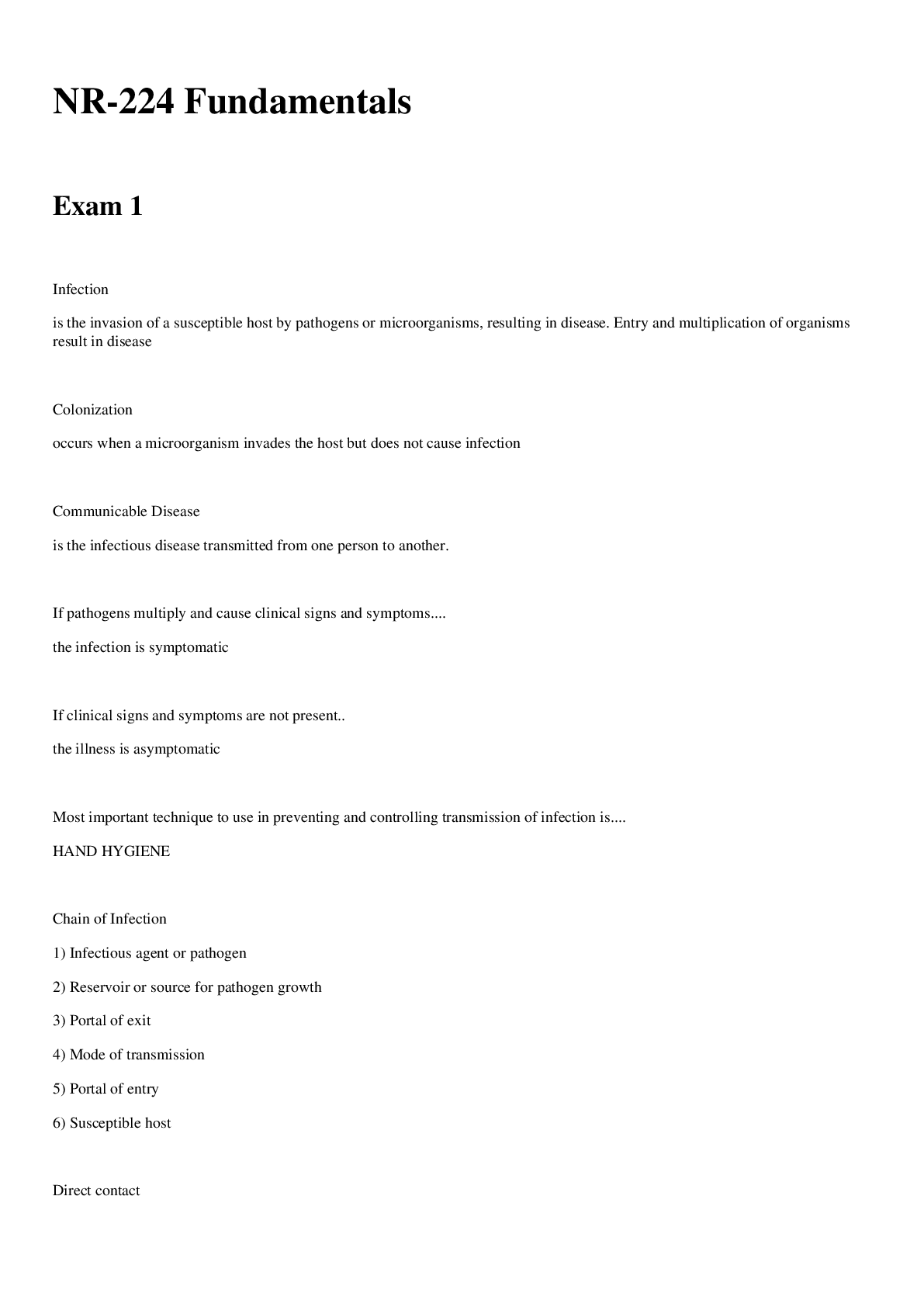
NR224 / NR 224: Fundamentals Exam 1 Latest Update Chamberlain College of Nursing
NR-224 Fundamentals Exam 1 1. Infection - is the invasion of a susceptible host by pathogens or microorganisms, resulting in disease. Entry and multiplication of organisms result in disease...
By quiz_bit , Uploaded: Nov 10, 2020
$9
Health Care> EXAM > NR224 / NR 224: Fundamentals Exam 1 (Latest Update) Chamberlain College of Nursing (All)
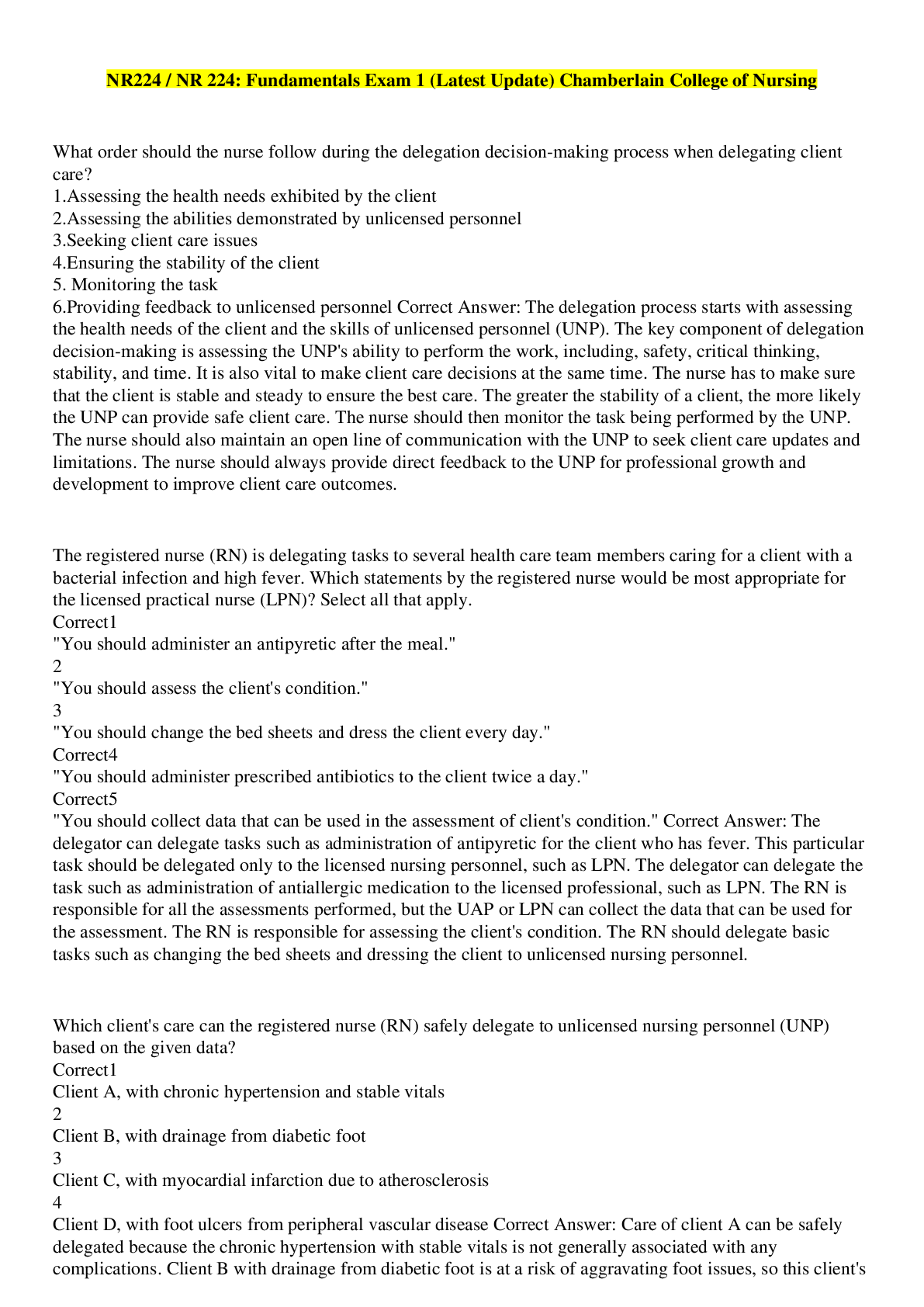
NR224 / NR 224: Fundamentals Exam 1 (Latest Update) Chamberlain College of Nursing
NR224 / NR 224: Fundamentals Exam 1 (Latest Update) Chamberlain College of Nursing What order should the nurse follow during the delegation decision-making process when delegating client care? 1.A...
By Crum , Uploaded: Aug 04, 2022
$17
*NURSING> EXAM > CNOR PRACTICE EXAM PREP BY CCI NEW 2022 ACTUAL EXAM QUESTIONS WITH ANSWERS GRADE A SOLUTION (All)

CNOR PRACTICE EXAM PREP BY CCI NEW 2022 ACTUAL EXAM QUESTIONS WITH ANSWERS GRADE A SOLUTION
Which patient population is more sensitive to dosage errors A. Male patients 25-40 B. Bariatric patients C. A patient with a history of polypharmacy D. Pediatric patients - CORRECT ANSWER D. Pedia...
By BRAINEDGE , Uploaded: Jul 04, 2022
$11
*NURSING> EXAM > NREMT Cognitive Exam updates 2022 Questions and Answers Grade A+ (All)
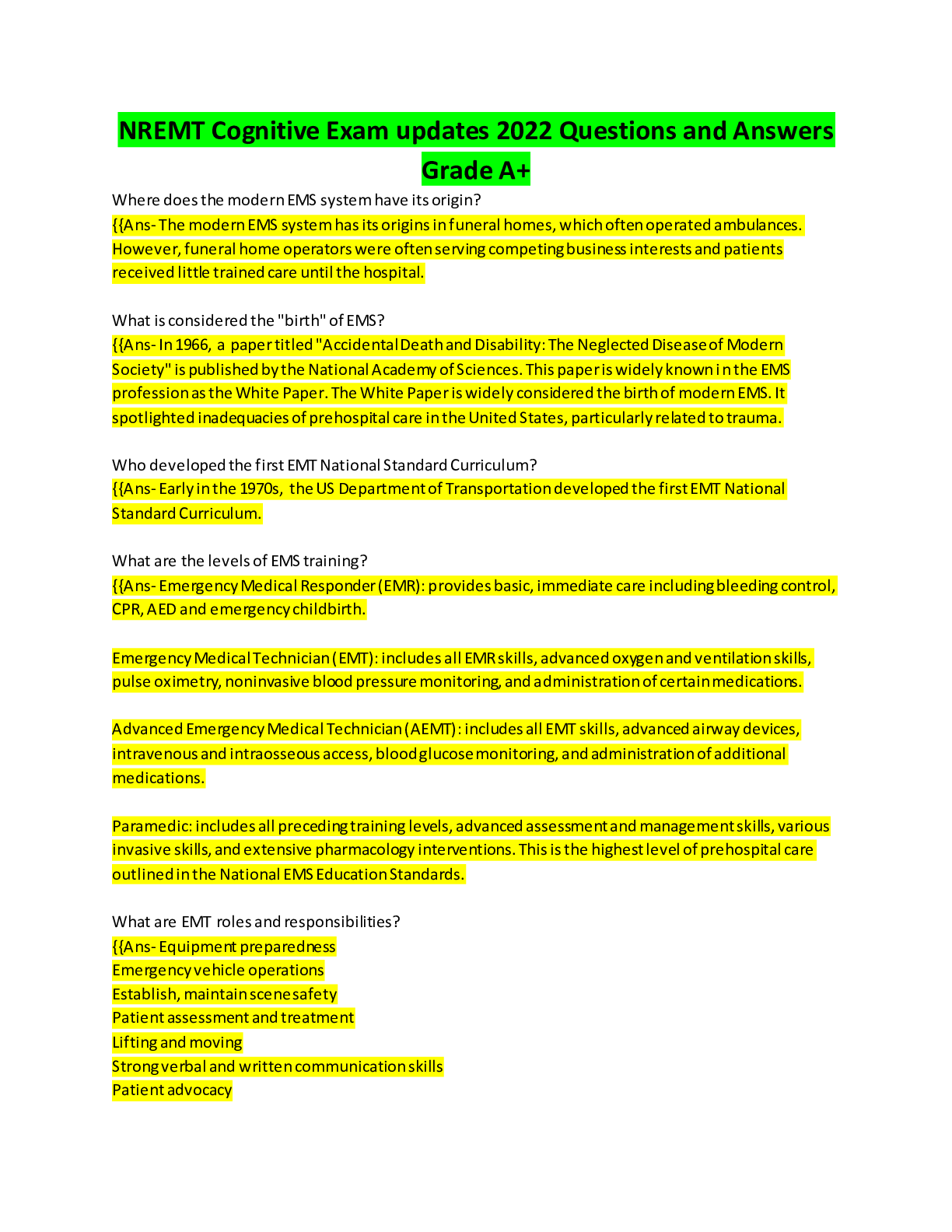
NREMT Cognitive Exam updates 2022 Questions and Answers Grade A+
NREMT Cognitive Exam updates 2022 Questions and Answers Grade A+ Where does the modern EMS system have its origin? {{Ans- The modern EMS system has its origins in funeral homes, which often operate...
By Tutorsammy , Uploaded: Jun 24, 2022
$8
*NURSING> EXAM > ATI Fundamentals Exam 100 Questions and Answers || LATEST 2020 / 2021 (All)
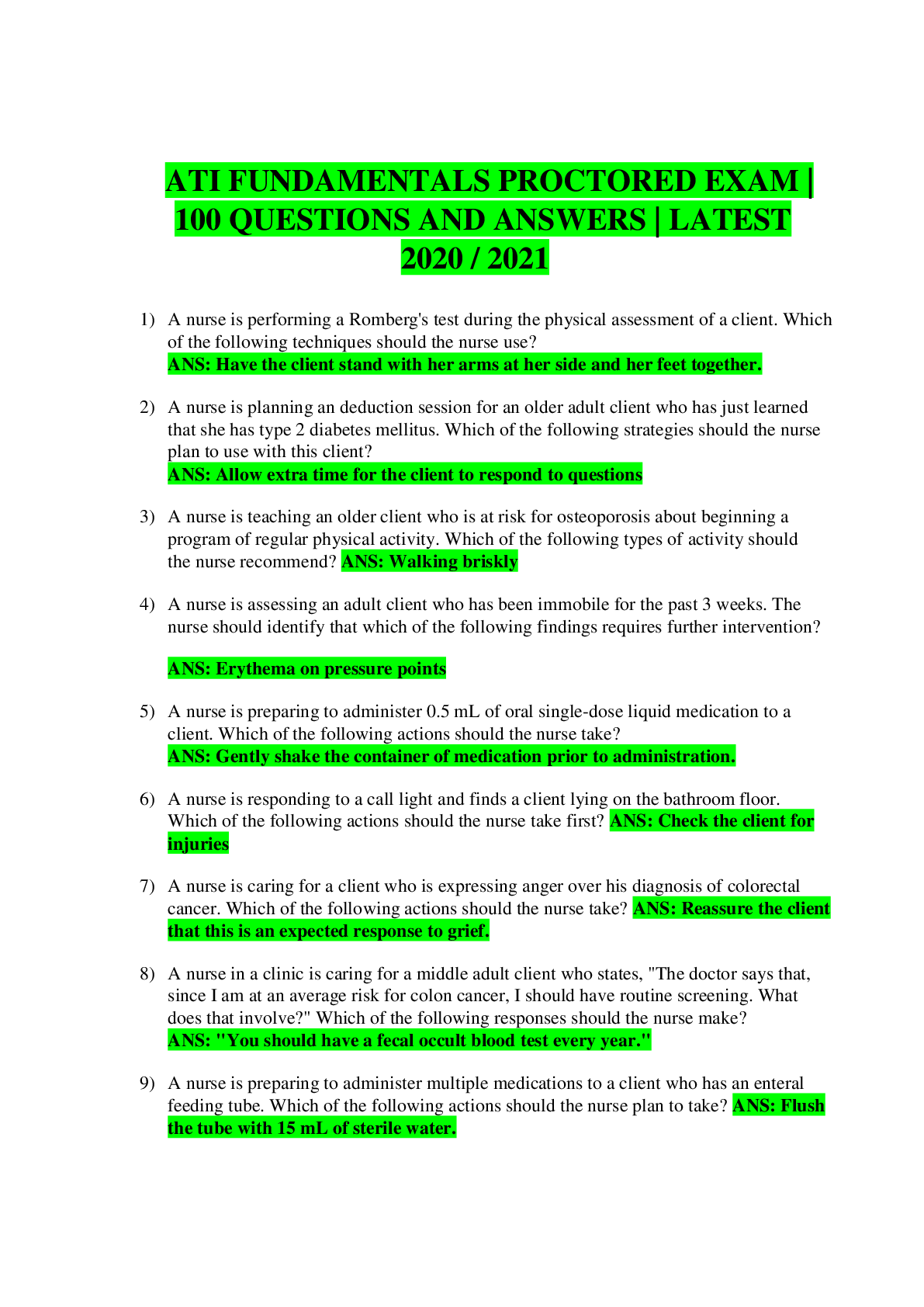
ATI Fundamentals Exam 100 Questions and Answers || LATEST 2020 / 2021
ATI Fundamentals Exam 100 Questions and Answers || LATEST 2020 / 2021 A nurse is performing a Romberg's test during the physical assessment of a client. Which of the following techniques should the...
By DENNIS RIXX , Uploaded: May 13, 2021
$20
*NURSING> EXAM > University of Texas ACLS Exam 2022 Verified Questions and Answers Grade A+ (All)
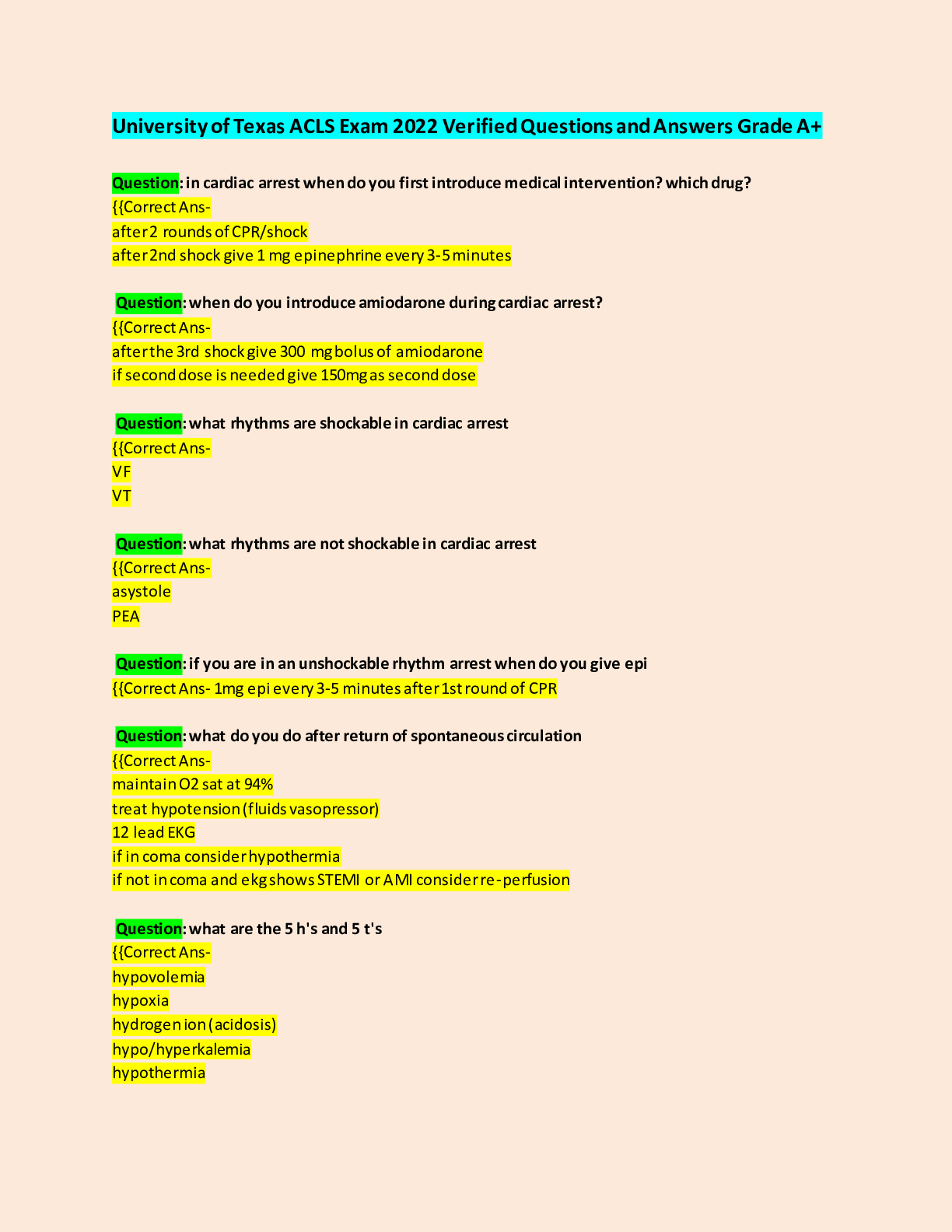
University of Texas ACLS Exam 2022 Verified Questions and Answers Grade A+
University of Texas ACLS Exam 2022 Verified Questions and Answers Grade A+ Question: in cardiac arrest when do you first introduce medical intervention? which drug? Question: when do you intro...
By Tutorsammy , Uploaded: May 15, 2022
$6
Health Care> EXAM > NUR2356: Multidimensional Care I / MDC 1 Exam 1 / Latest 2022:2023) Rasmussen/ Fundamentals Exam 1 (All)
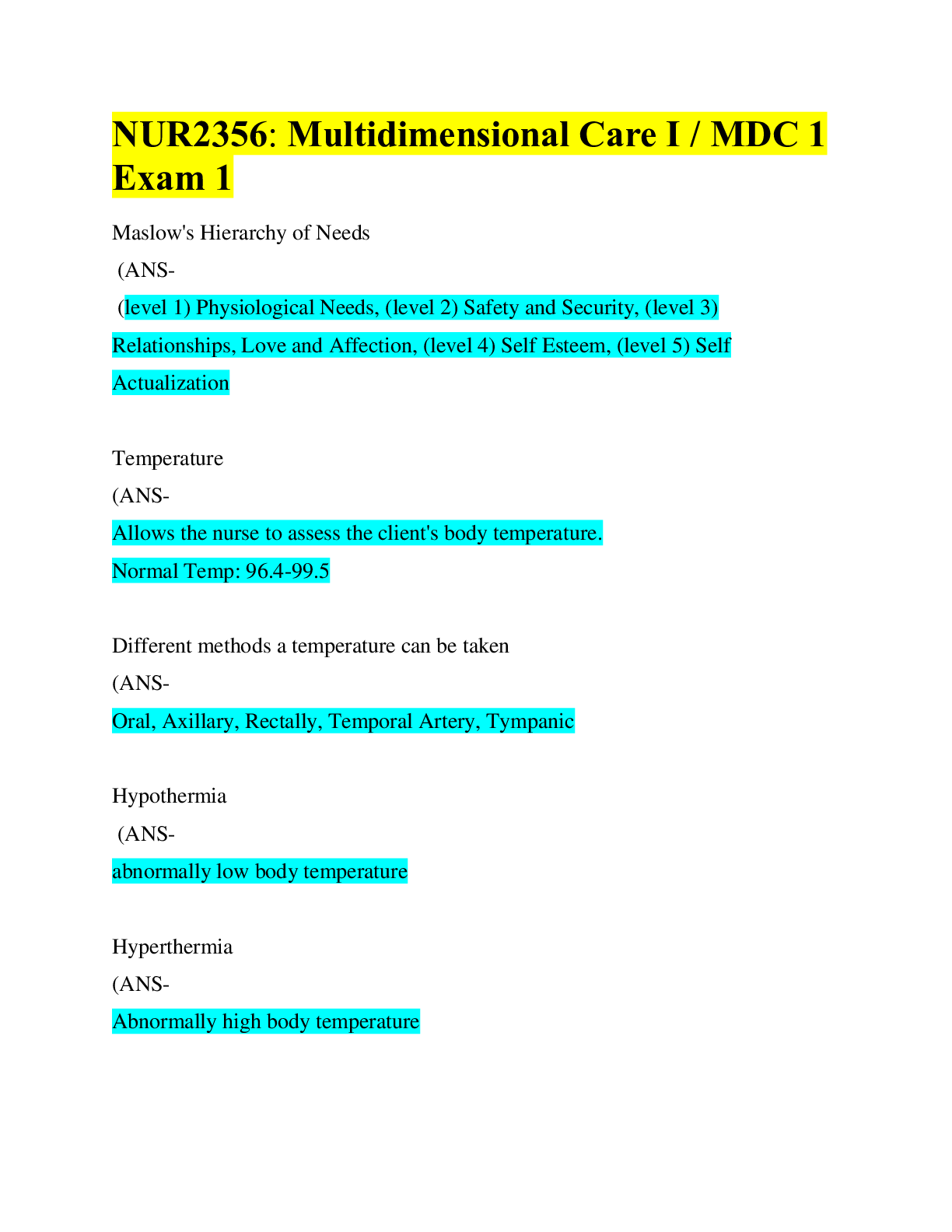
NUR2356: Multidimensional Care I / MDC 1 Exam 1 / Latest 2022:2023) Rasmussen/ Fundamentals Exam 1
NUR2356: Multidimensional Care I / MDC 1 Exam 1 Maslow's Hierarchy of Needs (ANS- (level 1) Physiological Needs, (level 2) Safety and Security, (level 3) Relationships, Love and Affection, (leve...
By Joy100 , Uploaded: May 07, 2022
$10
Document information
Connected school, study & course
About the document
Uploaded On
Aug 02, 2020
Number of pages
10
Written in
Additional information
This document has been written for:
Uploaded
Aug 02, 2020
Downloads
2
Views
270






